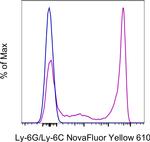Search Thermo Fisher Scientific
FIGURE: 1 / 4
Ly-6G/Ly-6C Antibody (M016T02Y03) in Flow




Product Details
M016T02Y03
Species Reactivity
Host/Isotype
Recommended Isotype Control
Class
Type
Clone
Conjugate
Excitation/Emission Max
Form
Concentration
Purification
Storage buffer
Contains
Storage conditions
Shipping conditions
RRID
Product Specific Information
Description: The RB6-8C5 monoclonal antibody reacts with mouse Ly-6G, a 21-25 kDa protein also known as the myeloid differentiation antigen Gr-1. A GPI-linked protein, Gr-1 is expressed by the myeloid lineage in a developmentally regulated manner in the bone marrow. While monocytes only express Gr-1 transiently during their bone marrow development, the expression of Gr-1 on bone marrow granulocytes as well as on peripheral neutrophils is a good marker for these populations.
eBioscience testing indicates that in the bone marrow and lysed whole blood, the antibody clone RB6-8C5 also stains cells that express the highest levels of Ly6c (as defined by staining with antibody clone HK1.4). It is recommended that 1A8-Ly6G (Product # 9668) be used when looking at Ly-6G specific targets.
eBioscience testing indicates that in the bone marrow and lysed whole blood, the antibody clone RB6-8C5 also stains cells that express the highest levels of Ly6c (as defined by staining with antibody clone HK1.4). It is recommended that 1A8-Ly6G (Product # 16-9668-82) be used when looking at Ly-6G specific targets.
Applications Reported: The RB6-8C5 antibody has been reported for use in flow cytometric analysis.
Our internal testing shows that NovaFluor Yellow 610 non-specifically stains B cells in SJL mice. Non-specific staining has not been observed in BALB/c or C57BL/6 mice. Other strains have not been tested. See the Antibody Testing Data for an example of this strain-dependent difference.
Applications Tested: The RB6-8C5 antibody has been tested by flow cytometric analysis of mouse bone marrow cells and splenocytes. This can be used at less than or equal to 0.4 µg per test. A test is defined as the amount (µg) of antibody that will stain a cell sample in a final volume of 100 µL. Cell number should be determined empirically but can range from 10^5 to 10^8 cells/test. It is recommended that the antibody be carefully titrated for optimal performance in the assay of interest.
Each NovaFluor conjugate or kit is shipped with CellBlox Blocking Buffer . Use this buffer whenever staining with NovaFluor conjugates, including single-color compensation controls using cells. Whenever possible, we recommend adding CellBlox Blocking Buffer to antibody cocktails/master mixes prior to combining with cells. Add 5 µL per sample (regardless of the number of NovaFluors in your panel) to use the antibody cocktail as intended. For single-color controls, use 5 µL of CellBlox Blocking Buffer per 100µL of cell sample containing 10^3 to 10^8 cells.
Excitation: 552 nm; Emission: 612 nm; Laser: 561 nm (Yellow) Laser
NovaFluor conjugates are based on Phiton™ technology utilizing novel nucleic acid dye structures that allow for engineered fluorescent signatures with consideration for spillover and spread impacts. Learn more .
Target Information
Granulocytes are a category of white blood cells characterised by the presence of granules in their cytoplasm. They are also called polymorphonuclear leukocytes (PMN or PML) because of the varying shapes of the nucleus, which is usually lobed into three segments. In common parlance, the term polymorphonuclear leukocyte often refers specifically to neutrophil granulocytes, the most abundant of the granulocytes. Granulocytes or PMN are released from the bone marrow by the regulatory complement proteins.
For Research Use Only. Not for use in diagnostic procedures. Not for resale without express authorization.
How to use the Panel Builder
Watch the video to learn how to use the Invitrogen Flow Cytometry Panel Builder to build your next flow cytometry panel in 5 easy steps.
References (0)
Bioinformatics
Protein Aliases: Granulocyte Marker; Ly-6C1; Ly-6C2; Ly-6G; Ly-6G.1; lymphocyte antigen 6 complex, locus C; lymphocyte antigen 6C precursor (Ly-6C); Lymphocyte antigen 6C1; Lymphocyte antigen 6C2; Lymphocyte antigen 6G; Lymphocyte antigen Ly-6C; lymphocyte differentiation antigen; PML; PMN
Gene Aliases: AA682074; AA959465; Gr-1; Gr1; Ly-6C; Ly-6C.2; Ly-6C1; Ly-6C2; Ly-6G; Ly6c; Ly6c1; Ly6c2; Ly6g
UniProt ID: (Mouse) P0CW02, (Mouse) P0CW03, (Mouse) P35461
Entrez Gene ID: (Mouse) 17067, (Mouse) 100041546, (Mouse) 546644

Performance Guarantee
If an Invitrogen™ antibody doesn't perform as described on our website or datasheet,we'll replace the product at no cost to you, or provide you with a credit for a future purchase.*
Learn more
We're here to help
Get expert recommendations for common problems or connect directly with an on staff expert for technical assistance related to applications, equipment and general product use.
Contact tech support

